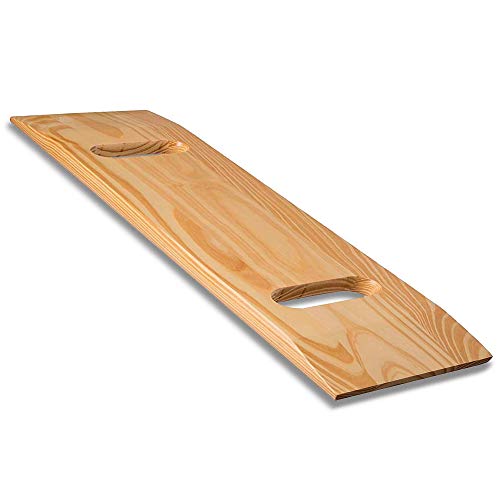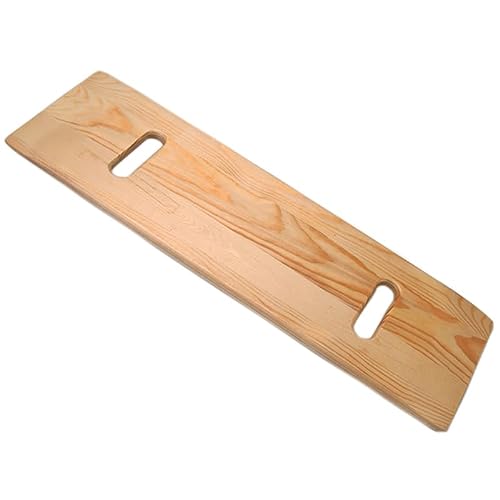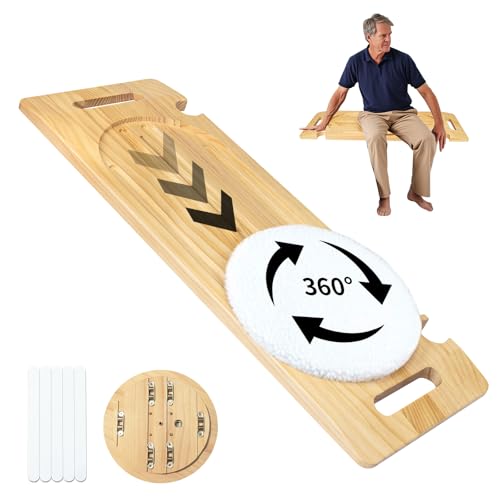The Best Transfer Boards

To help you find the perfect transfer board, we continuously put forth the effort to update and expand our list of recommendable transfer boards. Our team collects, edits and publishes new information, in order to present it to you in an accurate, significant and neatly arranged way.
Our Picks
8 More Transfer Board Alternatives
Table of Contents
Buying Guide
Mobility and Independence—Transfer Boards Buying Guide
Injuries, illness and aging can impact a person’s strength and mobility. Whether the limitation is short term or long, a transfer board can be instrumental in maintaining quality of life and independence for both its user and helpers.
These simple yet sturdy tools serve as safe, stable bridges between a starting point and a destination. When properly matched to the user and environment, the correct transfer board can make many everyday conveniences and activities we otherwise take for granted surprisingly accessible once more.
How To Use a Transfer Board
A transfer board’s purpose is to break one big, seemingly insurmountable movement into a graduated series of safer, smaller, more manageable steps. The goal is to eliminate the need for heavy lifting, something that can injure both people. Instead, transfer boards allow users to move themselves in increments and even rest between shifts. Some of the most common uses are helping someone move from a bed to a wheelchair or from a wheelchair to a car seat, for example.
While a helper often assists, many people learn to use a transfer board alone. Safety, however, demands that either way, the person using the board must be able to
1. Maintain a sitting position and lean forward. A person may need help sitting up from a reclining position. However, once they’re sitting vertically, they must be able to maintain that position. If they can’t, you may need a companion gait sling to stabilize them. Many variations of these supportive devices are also available.
2. Bear their weight on their hands and arms. Completing a transfer on a traditional board involves a methodical sideways lift and shift. The person must be able to support enough body weight to repeatedly lift and shift their hips to transit the board. If someone is unable to lift their body weight, advanced glider boards use pivots and slide seats to compensate.
3. Follow simple commands. Language barriers and impairments like stroke or hearing loss can be problematic.
With practice and familiarity, however, use of a well-designed transfer board can restore vital independence. Some users have been known to guard their preferred transfer board, reluctant to lose the one that works for them. From wood to plastic, traditional to almost space-aged, transfer boards come with so many features that you’re sure to find the right one for your personal situation.
Traditional Wooden Transfer Boards
Whether a person uses a transfer board independently or with assistance, the basic practice remains consistent. To start, the user typically leans to lift one hip and slide the board beneath them. The board spans the distance from their start point—a bed, for example—and their destination—a chair or perhaps a wheelchair. On reaching their destination, the person once again leans to lift a hip and remove the board.
Wooden boards are often beautifully finished, appearing more furniture-like than a health aid. The underside should be flat and level to prevent slippage. The top face should be beveled or gently tapered at each end to minimize friction. Some have either a single hand cutout or one near each end for easier handling. While these handles may at first appear too far center, cutouts too near the ends can result in fingers pinched between the board and its resting point.
Able to handle hefty weight loads, wooden transfer boards may be thicker than their polymerized cousins. They may also be sturdier and heavier, which can be a challenge for people who will be using the device alone, are unable to grasp tightly or wish to use it while traveling. However, many of the best ones have features to help users compensate:
- Duro-Med, for example, has a Bariatric Transfer Slide Board made of ¾-inch Southern yellow pine. The Duro-Med can hold over 700 pounds but weighs less than 5 itself. It measures 10 inches by 32 and has nonslip pads at either end for stability, nicely beveled ends and two well-spaced hand cutouts. Price runs around $70.[1]
- For a lighter-weight version, the Reliance Transfer Board is made of 11-ply Baltic birch, holds up to 450 pounds and weighs less than 3 pounds. It measures 30 inches by 7½ inches and is a little over half an inch thick. It has tapered ends, two hand cutouts and two topside grooves to aid grasping. While a bit narrow, it can fit into many spaces. Cost is about $70.[2]
- If you’re looking for hardwood, the MTS Medical Supply SafetySure Slotted Maple Transfer Board comes in 24- and 30-inch lengths. They’re of simple design, just 8 inches wide, with tapered ends and two generous cutouts. They weigh in at about 3 pounds but can handle 300. Cost is $55 to $65.[3]
- For a longer board to assist with inclines, Beasy makes a Bariatric Easy Grip model that measures 35 inches by 9½ inches and is rated for up to 600 pounds. Its orange coating offers Microban microbial protection and easy cleaning. It has two cutouts—one lengthwise, one widthwise. Longer, with a solid wood core, it’s just under 5 pounds. Cost is about $80.[4]
Polymer and Plastic Traditional Transfer Boards
These synthetic boards tend to be inexpensive, but they also are typically shorter and rated to support less weight—about 200 to 250 pounds. These can be helpful, however, in wet or messy situations since they are easy to clean. They’re also good for tight spaces. Since they usually weigh less than wooden boards, they’re convenient for transport:
- For thin and light, the MTS Medical Supply SafetySure Plastic Transfer Board is less than half an inch thick and weighs just 2 pounds. It measures 23 inches by 12 inches and is rated for 250 pounds. It has two hand cutouts, one at each end. Cost is just $35.[5]
- Also rated for 250 pounds, the DMI Transfer Slide Board is a bit longer, a bit over 28 inches. It’s just under 9 inches wide, with tapered ends but nearly 2 inches thick at its middle. Contoured lengthwise grooves can handle water or other liquids. At 3½ pounds, it has no handles but is economical—a mere $15 to $20.[6]
Notched Transfer Boards
Environments can present many obstacles to easy movement. Wheelchair arms and wheels can present challenges. Not all arms can be raised. Wheels can get in the way. Furniture contours and fixtures can entail unexpected obstructions or instability. Some people find transfer boards with notches, curves or other features helpful:
- The SafetySure Wood Transfer Board is double-notched, with a cutout along each side to allow you to hook the board from either direction for extra stability. It comes in both 24- and 29-inch lengths and is thin at just half an inch thick and 8 inches wide; the shorter model has one hand cutout while the longer has two. It supports up to 400 pounds yet only weighs about 2½ pounds itself. Cost is about $50 to $60.[7]
- The Beasy Standard Notched Wood Transfer Board is similar but adds the benefit of a Microban coating in green. At 29 inches by 9½, it supports 450 pounds and weighs about 3½. Cost runs about $80.[8]
- For a more versatile cutout, the Therafin Offset Transfer Board has a unique, sturdy contour and three hand cutouts. Made of seven-ply birch, it measures 24 inches by 11½ inches and is less than half an inch thick. It weighs less than 2½ pounds but will support 400. Cost is about $60.[9]
- If you’re looking for a transfer board tailored to toileting, a number of manufacturers make them specifically for wheelchair-to-toilet transfers. They typically have a notch along one side and extensive contouring to match a toilet seat. Therafin’s birch version costs about $100 while Beasy’s yellow Microban model runs about $80.[10,11]
Curved Transfer Boards
Going in a slightly different direction, several manufacturers offer transfer boards that are curved. Boards that have a bit of an arc can be helpful for getting around some obstructions like fixed wheelchair arms. However, the greater the curve and the longer the length, the less stable they become. That said, some boards do offer a slight curve along with balanced stability:
- The MTS Medical Supply SafetySure Curved Transfer Board has slight notches on the inside of the curve and a cutout forming a handle on the outside curve for easy carrying. It could easily double as a lap desk. It measures 28 inches by 12 inches and is only half an inch thick. It can support 250 pounds but only weighs about 2½. Cost runs about $45.[12]
- A bit more heavy-duty, the Days Curved Transfer Board for Wheelchair Users supports up to 336 pounds and is even rated MRI-safe. The board measures 27⅝ inches by 14⅝ inches but tapers to 10⅛ inches in the middle. Each end has nonslip pads. It’s made of sturdy waterproof plastic board resistant to chipping or splintering but weighs a bit over 5 pounds. Cost is about $75.[13]
- A full 32 inches long and 9½ inches wide, the Beasy Standard Curved Transfer Board is made of wood. It’s a slim half an inch thick and coated in a light apple green Microban antimicrobial finish. Rated for up to 400 pounds, it weighs about 4½ pounds. Cost runs around $90.[14]
Slide and Glide Boards
The term “slide board” often seems interchangeable with the term “transfer board.” However, there are a few true slide boards that are clever and in some situations can do much of the work for you. Beasy makes them, and the concept is surprisingly simple:
- The base spans the distance between the two points you want to bridge.
- The base has a slot that runs the length of the board’s middle.
- A round seat sits in the slot, gliding freely from one end to the other and back.
- The seat pivots 360 degrees to allow the user to turn as needed.
The design relieves stresses on hands, arms and shoulders and is frictionless. However, while it allows the rider to simply glide, inclines do require care that users don’t descend too quickly or backslide while rising.
Beasy makes three glider models. They’re made of polymerized plastic treated with Microban, an antimicrobial coating. Bases are an inch thick while seats account for another half an inch. All three are rated to support up to 400 pounds:
- Model 1100 is the original board known as the BeasyTrans. Despite a slight S shape, it’s basically a straight 40-inch board. Beasy’s longest glider model, it weighs in at 6½ pounds.[15]
- At 27½ inches long, Model 1200, the Beasy II, is Beasy’s shortest board, weighing 4½ pounds.[16]
- In between is Model 1300, the BeasyGlyder. It offers 32 inches on a gentle curve designed to solve problems like wheelchair arms or other obstructions. It also weighs 4½ pounds.[17]
As with most things, the added complexity and engineering mean that Beasy glider boards are more expensive—in the $200 range. As a premium product, however, they also offer a range of accessories like carrying cases, a wheelchair bag and padded polyester seat cushions.[18-21]
Finding Solutions That Work for You
Transfer boards come in every shape, size, material and color imaginable. However, the right transfer board matched to the right situation can make the difference in determining whether
- someone can remain in their own home;
- someone can leave their home and go elsewhere—in a car, for example;
- someone can participate in family and life events;
- someone can care for themselves with dignity and perhaps have a degree of privacy; and
- caregivers can care for someone without injuring themselves or the person they’re trying to help.
The medical aid and healthcare industries are constantly developing new devices to help people maintain their mobility and independence. Sometimes, the answer can be as simple as a board—a transfer board.
General References#no_title# #no_title#
Top Rated Transfer Boards
If you're looking into finding the best rated transfer board, you should probable check out the MABIS DMI Board. We looked at various sources of reviews and found this one to have the best mix between review count and average rating stars.
The Lowest Price We Could Find
Often, going for the best price is a simple but good option. With a price of $26.99 (last checked this morning), we do not list any other transfer board cheaper than the Weybaihe Slide Board. Just remember that it's not always the best option to go for the cheapest one.
The Transfer Board With the Most Reviews
With at least 1016 reviews and counting, the MABIS DMI Board might be another option to consider. This large amount of reviews signalizes that many people are using it, with most of them beeing satisfied.
High Quality Transfer Boards
It's quite rare that the saying "You get what you pay for" turns out incorrect. If you have the money on the sideline, feel free to choose the most expensive item from our list: The WodGod Wooden Slide Board currently sells for $79.99.
The Transfer Board With the Most Clicks
If you trust us and our users, feel free to check out the MABIS DMI Board. Our statistics say that it is the most favorite Transfer Board from the list above.
Our Bestseller
If you're still undecided, I would recommend that you go with the masses and choose the top selling transfer board: The MABIS DMI Board is the hottest bestseller in this category right now.
Transfer Board Reviews
Further Reading on Transfer Boards
Research
A hospital bed has a transfer board which can be moved between a retracted position and an operational position. In the operational position, the board extends outwardly from an edge portion of the bed mattress and has an upwardly facing surface level with the top …
A stretcher includes a patient support portion vertically movably supported on a wheeled base by a lift arrangement. Two pivot members are supported on the support portion for pivotal movement about respective vertical axes, and each support a respective arm for …
A method for placing material onto a target board by means of a transfer board comprising a plurality of blind holes, the method comprising the steps of immersing the transfer board in a material bath, wherein a first pressure acts on the material bath and a second pressure acts …
Useful Videos
The BeasyTrans, Beasy II and BeasyGlyder premium transfer systems provide a more upright, dignified lateral slide. Unlike other transfer boards, there is no ...
Comments
About this Article
It was last updated on 2025-12-17 08:17:39 and has been viewed 7442 times.


